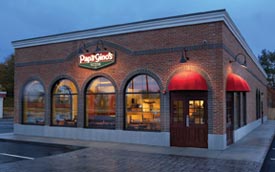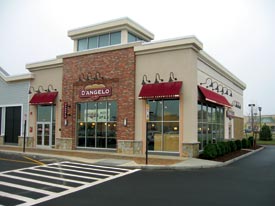Earlier this spring, the restaurant community braced itself to deal with a sharp increase in food prices that came about due to rising oil costs and other factors. Undoubtedly, we all have to be aware of rising food costs, but increased energy costs is just as important an issue facing foodservice facilities today. It's a topic that facility professionals regularly discuss and often try to tackle. Unfortunately, our efforts tend to get stalled by the notion that reducing energy is pretty complex, costly or both.

We at Papa Gino's and D'Angelo have been able to overcome these traditional obstacles by partnering with our service agents and empowering them to help us uncover solutions. The net result is that we have been able to lower our electricity consumption at the restaurant level thanks to walk-in freezer and refrigerator updates.
Papa Gino's Pizzeria and D'Angelo Grilled Sandwiches are fast-casual restaurant chains with more than 320 locations in the northeastern United States. Both Papa Gino's and D'Angelo are committed to providing high-quality products; attentive service; clean, convenient and attractive restaurants; and a premium value experience for every guest. The company culture, which is characterized by its values, a strong work ethic and the fair treatment of people, includes a large number of people who have spent their entire working lives in these restaurants, keeping the passion for excellence alive. It is the responsibility of me and my team to manage all of the ongoing capital improvements, repairs and maintenance as well as play a role in the development of any new units and remodels.
Back in 2007, when the economy started to sputter, we began looking for ways to reduce energy consumption. The goal was to reduce energy use in our existing Papa Gino's and D'Angelo locations without a massive swapping out of equipment. Like most foodservice operators, we looked at lighting right away. With the availability of rebates, this was a no-brainer for us, but we wanted to do more. When looking beyond lighting for ways to lower energy consumption, the options can become expensive and complicated rather quickly.
In 2009, like many foodservice operators, we took another look at our refrigeration equipment because these units consume a significant chunk of our overall electricity. We had already replaced a large portion of our self-contained refrigeration units, so we brought in our local service agent to discuss what we could do to make our walk-in units more energy efficient.
 Together we came up with the idea of switching from shaded pole motors to ECMs (electronically commuted motors) for the walk-in refrigerator and freezer evaporator fans. These ECMs take normal alternating current power and convert it to direct current power. These contain a built-in controller as well as permanent magnets. Together, these components allow the motor to monitor its speed and self-adjust as necessary in order to maintain a constant air volume through the walk-in evaporators. The ability to self-adjust allows the ECM to use only the energy it needs to move the air volume necessary for the evaporator to function properly. The shaded pole motor has no such discretion and, in fact, is very wasteful, particularly when used in refrigeration systems.
Together we came up with the idea of switching from shaded pole motors to ECMs (electronically commuted motors) for the walk-in refrigerator and freezer evaporator fans. These ECMs take normal alternating current power and convert it to direct current power. These contain a built-in controller as well as permanent magnets. Together, these components allow the motor to monitor its speed and self-adjust as necessary in order to maintain a constant air volume through the walk-in evaporators. The ability to self-adjust allows the ECM to use only the energy it needs to move the air volume necessary for the evaporator to function properly. The shaded pole motor has no such discretion and, in fact, is very wasteful, particularly when used in refrigeration systems.
Of course, I am not one to just believe what I'm told, so we tested the motors on a walk-in unit in our research and development kitchen. In doing so, we placed an ECM motor side-by-side with an existing shaded-pole motor in the same evaporator, and monitored the results.
After 31 days of testing, we saw that the new motor had used only 12 kw hours of electricity compared to 100 kw hours for the original motor. This translated to an estimated annual savings of $284 per motor for the walk-in freezer and $248 for the walk-in refrigerator. And when you take into account the fact that each walk-in unit has two-to-three motors, the enterprise-wide savings start to add up rather quickly.
 The energy consumption for the walk-in freezers was slightly better than for the refrigerators, because we were able to reconfigure the controls so that these fans only operate when the condensing unit is running. Included in the noted savings is a reduction in heat load within the walk-in. The energy that the shaded-pole motor wastes is converted to heat and then released inside the walk-in; this heat then has to be removed by the refrigeration system. By eliminating this undesirable heat load, you reduce the run time and therefore reduce the energy consumption of the refrigeration system, not to mention lessening the wear and tear.
The energy consumption for the walk-in freezers was slightly better than for the refrigerators, because we were able to reconfigure the controls so that these fans only operate when the condensing unit is running. Included in the noted savings is a reduction in heat load within the walk-in. The energy that the shaded-pole motor wastes is converted to heat and then released inside the walk-in; this heat then has to be removed by the refrigeration system. By eliminating this undesirable heat load, you reduce the run time and therefore reduce the energy consumption of the refrigeration system, not to mention lessening the wear and tear.
While many utility companies offer incentives for businesses like ours to reduce energy consumption, figuring out how to qualify for them can require some effort. From our perspective, it was critical to have a partner that could serve as the company's liaison with the utility company to ensure a smoother process that resulted in the rebates being issued.
The net cost for this project would have been $258,000 without the rebates. In our partnership, the service agent assumed the full liability – paperwork included – to obtain the local utility company rebates. As a result, our net expense was $151,000 to achieve savings of more than $200,000 per year. This does not take into account our lower maintenance expenses, which came about as a result of having all new fan motors.
Lessons Learned
Before getting started, it is important to talk to the utility company decision-makers to better understand what information is needed in order to receive an incentive. Other than lighting, most any incentive you receive will be a custom one. Your partner needs to have a local presence and understand how to work with all of the players. It is important to know who is making the decisions at the utility and how to work with that person so they can provide the appropriate information in the proper format. Getting the approval of the first utility company did make it easier for us to get the others to participate.
This does require a time investment on the part of the service agent, particularly if they are inexperienced. But once successful, the service agent can use this experience to show other multi-unit customers what they have accomplished. In our case, this project served as a vehicle for our service agent to generate more sales. I encouraged them to share this knowledge with other restaurants because, from a corporate and social responsibility perspective, we want to help other companies save energy. Based on the results of this program, we have talked with other equipment manufacturers about including ECM motors in certain pieces of equipment. We now also have achieved further success using these motors in our exhaust fans.
The other net benefit of a project like this is that it whets your appetite. After having this type of success, our attitude was "The sky is the limit. What else



